 To the Rhine |
 Table of Contents |
 Photos, Officers, page 38 |
 To the Rhine |
 Table of Contents |
 Photos, Officers, page 38 |
The bridge at Oppenheim had been thrown across the Rhine several days before by the 90th Infantry Division. The Fifth Infantry Division had crossed behind it to help expand the bridgehead. Then came the Fourth Armored to pass through the 90th; and the Fourth was just completing its crossing when the Sixth arrived early the morning of March 25th at its assembly area west of the river near Dexheim. The Sixth was to move through the Fifth, take Frankfurt to the northeast, and then drive north to Giessen. Combat Command B crossed the Rhine in the morning. Just after noon Combat Command A followed. In its columns was the 212th, split again into two sections, one to support Task Force Lagrew and his 15th Tank Battalion, and the other to march with Task Force Britton and the Ninth Infantry Battalion.
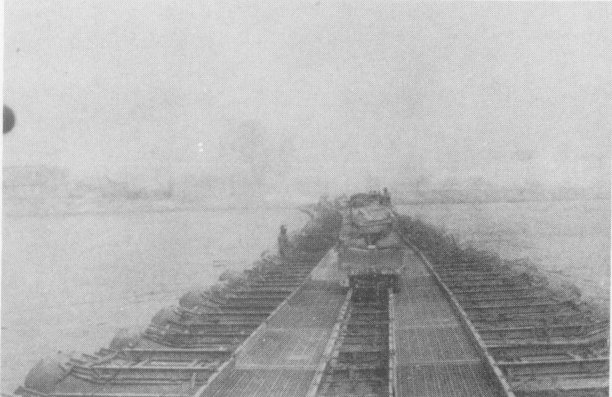
About twenty miles was the extent of the combat command's advance by nightfall; and since resistance was being met from the Frankfurt anti-aircraft defenses, both columns held up for the night. The right column stopped in the vicinity of Morpelden; the left column occupied an assembly area east of Russelsheim. The next day the Main was reached at Frankfurt, and the river was crossed by a few troops over a partially blown bridge, but it was a tough job. March 26 was a very "hot" day for Combat Command A. All elements were harassed continually by the large number of antiaircraft weapons positioned around Frankfurt, which were now being used as ground weapons. They were manned mostly by fanatical youth who threw everything they had at the advancing Americans.
By mid-afternoon, however, despite the savage ground ack-ack fire, the command reached the south bank of the Main 6pposite the center of Frankfurt, where one of the few remaining bridges still stood.Before the Germans could blow it, Lagrew had a platoon of tanks across; and after it was partially destroyed a few moments later, infantry from Britton's task force followed on foot. But the bridgehead met fierce resistance from all sides, and the bridge itself was under continual fire from every type of German weapon; it could not be repaired until the area to its north was cleared and the bridgehead enlarged. The Sixth had a march to make, however, so the Frankfurt clean-up was left to the Fifth Infantry Division, and the Sixth moved east almost to Hanau to cross again on a 9Oth Division bridge.
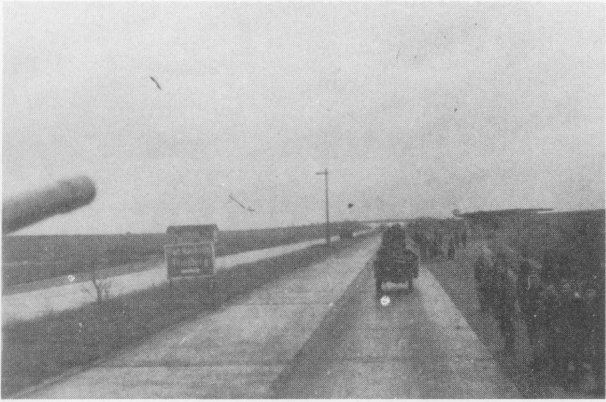
For the battle around the Frankfurt bridge, the 212th operated as a single unit again, and so remained for the balance of the war. In the afternoon of the 26th, both sections displaced to positions around a large airport south of Frankfurt, and before dark they merged into one battalion when the two fire direction centers were combined. Firing was heavy throughout the afternoon and night; smoke was delivered to screen the bridge operations, and counter-battery fire was sent against German ack-ack and artillery positions. The battalion positions received their share of the constant German fire also; and some of it was very effective. At 1845 three Service Battery men were seriously wounded by a tree burst: Tec. 4 Lester M. Cannedy, Pfc. Ira C. Rounds, and Pvt. Anton R. Silvia. A German booby trap in the airport also claimed two victims: S. Sgts. Donald F. Dean and Robert V. Matteson, C Battery.
The next morning the battalion displaced to one of the suburbs of Frankfurt, about two miles south of the river. There smoke missions and counter-battery fire continued until the next afternoon, March 28, when the division took off again for Giessen.
The battalion left its positions at 1700 in the column of the 15th Tank Battalion, now Task Force Sussinan. The crossing of the Main at Dietesheim was uneventful, as was the entire march the rest of the evening; no German resistance was encountered. After a sleep halt from midnight to 0700, the march was resumed on the 29th. Bits of opposition were met here and there along the route, but all were crushed with ease, and by noon the combat command had contacted the Ninth Armored Division at Grossen-Linden, just south of Giessen. Mission accomplished. The link-up at Grossen-Linden was with the right flank of the Ninth Armored advancing east from its famous Remagen bridgehead, so Giessen to the north fell in its sector.
There was no time for stopping, however. The German army was crumbling. The bulk of it was being surrounded and chewed to bits in the great Ruhr pocket to the north; and what remained elsewhere were mostly disorganized, bewildered groups. Continued lightning drives could finish them in short order. So another lightning advance was the order of the day for the Sixth Armored on March 30th, this time in the direction of industrial Kassel to the north. The division prepared for the mission by moving late the 29th to an assembly area around Steinback, ten miles to the east. From there the drive jumped off early the next morning, and by nightfall the outer defenses of Kassel were reached. German resistance increased slightly, particularly at Alsfeld, where the 15th Tank Battalion spent several hours cleaning out the town and the 212th did its first firing since Frankfurt; but nevertheless the day's drive netted some 70 miles. Combat Command A did not stop until its Ninth Infantry Battalion had reached Wabern, where the first Kassel defenders were met. Sussinan' 5 force and the 212th held up for the night just south of Wabern at Unshausen.
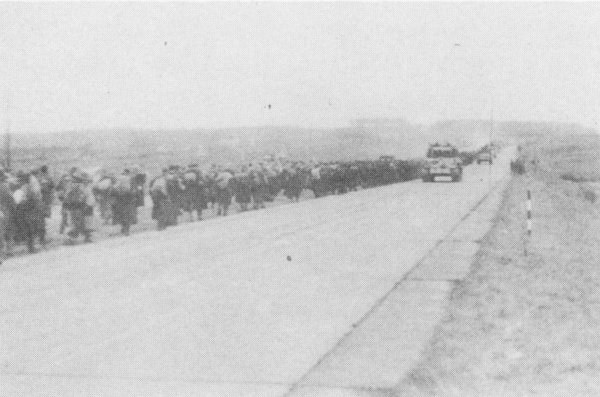
The next morning Task Force Sussinan was ordered northeast to seize a bridge across the Fulda River at Melsungen, and thus enable the combat command to bypass the stiff resistance north of Wabern. Melsungen was reached without difficulty, but before the river could be crossed, all the bridges were blown; and the force was ordered back to Unshausen. Immediately the 212th was taken from Sussinan's force and assigned to direct support of Root's Ninth Armored Infantry Battalion which was to push through the resistance to the north. The 212th occupied positions around Wabern initially, but at 0400 April lit had to displace seven miles northward, and at daybreak another two miles to positions around Dissen. There the advance bogged down, however, when the head of the column ran into stiffened anti-tank and artillery resistance around Holzhausen. After spending the rest of the day, Easter Sunday, trying to knock out the guns, Root turned over the capture of Kassel to the 80th Infantry Division, and his force was ordered back again to Unshausen to prepare for a drive to the east. Leipzig was the new division objective.
The 212th reached Unshausen at 2200. Two hours later it was part of Task Force Sussinan again, and moving out for a night march to cross the Fulda over a bridge taken by Combat Command B south of Melsungen. After crossing the river, the column swung north to Melsungen, and thence northeast to Gunsterode. There the 212th bad to occupy positions; Hess Lichtenau, the next town along the route, was strongly defended. 1,500 rounds of artillery, however, poured into the town all day, plus direct fire from the tanks, took care of it, and at 1900 the march was resumed. A bivouac area south of Vockerode was reached by 0300, and there the column held up for the balance of the night. The advance to Vockerode met with no enemy resistance, yet it was one of the most difficult marches the battalion experienced; the night was pitch black, and the road was a winding mountain trail with constant hair-pin turns. Captain Winthrop S. Jameson, Jr., A Battery Commander, received a serious foot injury during the night when be was hit by a truck in the darkness.
Combat Command A spent the next day, April 3, reconnoitering for a bridge across the next obstacle, the Werra River. None was found all day, but when in mid-afternoon a prospect loomed at Bad Sooden, the 212th displaced to Frankenhain to be in a support position. By the end of the day, however, the operation was abandoned, and the combat command was ordered to cross the river on a bridge to the east taken in the afternoon by Combat Command B. The troops of Combat Command B cleared the bridge shortly after midnight, and Task Force Sussinan began its march to the river at 0200.
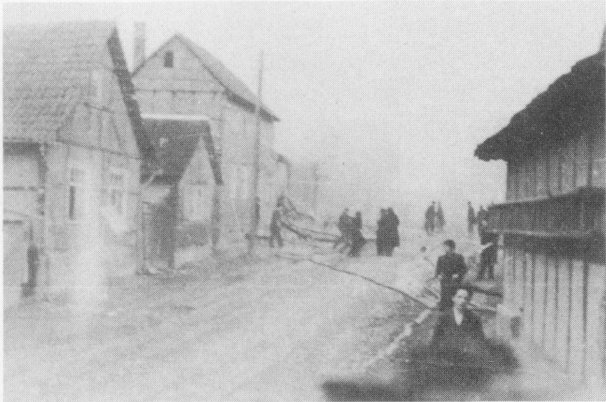
The column crossed the river at daybreak, and then unleashed another long drive that took it past Mulhausen, fifty miles away, by the end of the day. All resistance along the way was pushed aside with ease; the battalion occupied positions only once, and then for only a few minutes. German air activity increased, however, and harassed the column all day long. But no serious damage or delay was caused, and by 1800 Sussman's ??? force had swept past Mulbausen on the north to link up at Grosgrab with a column of Combat Command B which had encircled Mulhausen on the south. Combat Command A's other column, Task Force Root, was poised west of the city to complete the net.
Mulhausen was taken during the night without a shot. The next day the division was ordered to assemble east of Mulhausen and discontinue its eastward advance temporarily. Armor all along the front was being stopped to let supplies catch up, and to give infantry divisions a chance to clear the pockets created by the armored spearheads. Combat Command A's assigned area at Langensalza, however, was held by Germans who refused to surrender, so a fight was necessary. A good portion of the town was penetrated by nightfall, but the 2l2th spent the night in position about two miles west around Schonstedt, from where it had supported the attack during the afternoon. Lt. James E. Biggs of B Battery was seriously wounded by an enemy bomb during the day's action.
On April 6 the combat command completely occupied Langensalza, and it remained there until April 11, when the division launched another drive toward the Russians. Parts of the command, however, including the 212th, spent part of the period a few miles to the north; when an attack from the north was reported imminent, the 15th Tank Battalion was ordered into a defensive position for a day, and the 212th supported it from Thamsbruck.
On the 10th, with the battalion back at Langensalza again, General Grow presented more awards. Lt. Col. Pope was given the Silver Star for gallantry in action and a second Oak Leaf Cluster to his Bronze Star Medal for meritorious service. Bronze Star Medals were awarded to Lts. Robert R. Wells, Headquarters Battery, and Nib R. Salemi, Battery C, for meritorious service as forward observers; and to T. Sgt. Richard McGlinchey, Tec. 3 Lawrence E. Jensen, Tec. 4 Manreece Alewine, all of Headquarters Battery, and Cpl. David J. Machietto and Tec. 5 Andrew Ordog, Service Battery.
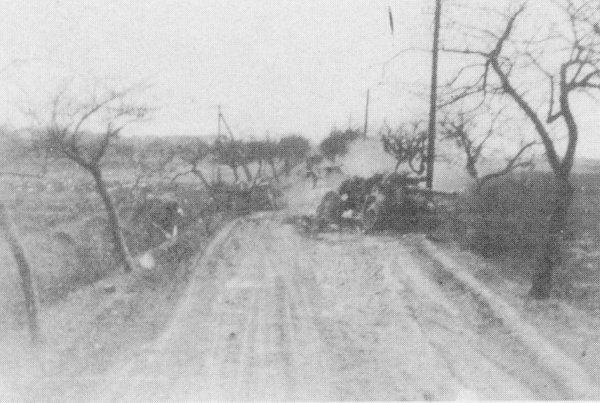
The same day the Sixth Armored Division was ordered to resume its advance to the east the following morning, passing south of Leipzig, and to seize a bridgehead across the Elbe. Task Force Sussinan began the new offensive with a swift drive that by 1800 the 11th had taken it almost sixty miles eastward to the Saale River at Kamburg. There resistance at the bridge caused the first major delay of the day, and after securing the bridge, the column held up for the night. The 212th occupied positions two miles west at Schweinhausen.
The next morning, April 12th, after initially assembling east of Kamburg, the Column resumed its march at 0900. But no smashing drive was forthcoming. After a 15 mile advance, resistance at Weickersdorf held up the task force, and four miles later at Droyssig the column was stopped cold by infantry, mortars, artillery, and more ground ack-ack. The defenses around Zeitz had been hit; and these defenses, still manned and active, were to cause the task force, and in fact the whole division, much trouble during the next few days. To support the Droyssig action, the 212th stopped at 1500 in positions around Romsdorf, where a few moments later Headquarters Battery, still in column along the road, received a terrific artillery and mortar shelling. Two men were killed: Tec. 5 Leslie H. Kirk and Pvt. Samuel J. Facas; and four were seriously wounded: Lt. Neuswirth, Tec. 5 Yocius, and Tec. 5 Westlund, all of the battery's attached anti-aircraft personnel, and Pvt. Albert A. DeMaris. Westlund died later from his wounds.
The shelling of the area stopped as quickly as it had started, and the battalion remained in its Romsdorf positions the balance of the day, firing counter-battery missions. The next day it continued its fire on enemy artillery positions while the advance elements of the task force reconnoitered for a route south around Droyssig and across the Elster River beyond. A bridge was taken near Schkaudit, and at 1700 the battalion displaced south a few miles to Weissenborn to support the crossing.
The next morning, April 14, the eastward march was resumed at 0645, but 35 anti-aircraft guns at Guessnitz, five miles beyond the river, soon held up the advance. The 212th stopped at Roden to pour 1,000 rounds on them, and by mid-afternoon they were either neutralized or destroyed; the engineers demolitioned what remained. At 1700 the column again started eastward, and covered twelve miles before darkness and more dual purpose 88's forced a halt for the night near Wurchwitz.
The 88's were at Nissina, 33 of them, and they held up the column most of the morning the 15th. But they were given the same treatment as those of the previous day, and at 1100 Task Force Sussinan took off on another race, its last of the war. By 2000 that night, it had reached the Zschopau River at Mittweida, and had established two bridgeheads on the east bank. There it and the division were ordered to hold up and establish a defensive position to await the arrival of the Russians from the east. The Sixth Armored Division's participation in World War II was almost over. But the division -- and the 212th -- could well afford to stop. The offensive that started around Sarreguemines on March 15 had covered over 450 miles when it reached Mittweida; and the Sixth used only one month for the job.
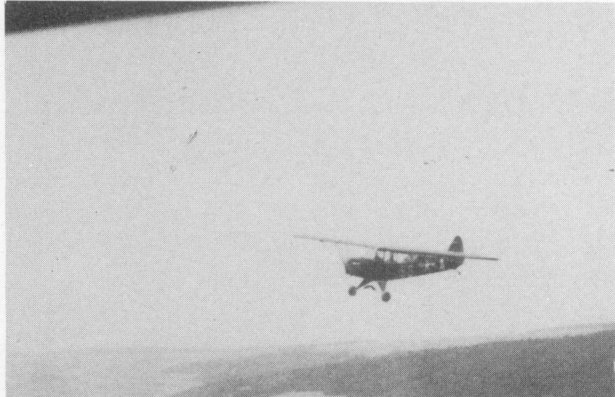
The division's casualties too, as in most swift drives, were comparatively light. The toll in the 212th, however, was somewhat higher than its normal for line warfare; two men were killed and 18 were wounded or injured seriously enough to need evacuation. Besides those already mentioned, Pfc. Hollis B. Meyer, Battery A, was wounded by a sniper just east of the Rhine on March 25; Cpl. Wilbert Erwin of B Battery, a member of a forward observer party, was injured during the night of March 31 when a German Tiger tank crashed into the leading elements of Task Force Root advancing north from Wabern; and Tec. 4 Arthur Harvishak was wounded by small arms fire on April 14, the day before the offensive was halted along the Zschopau.
The division held its line along the Zschopau for the next eight days, engaging in little more than patrol activity; and the 212th supported the defensive position from the west edge of Mittweida. On April 24 the division was suddenly ordered back to the Mulde River, 15 miles westward; international agreement, it was said, had set the Mulde River as the line along which the Russians and Americans would meet, and the Sixth had advanced too far. At Mittweida, the Sixth stood farther east than any other American division in the European Theater. Patrols from Combat Command A continued as far east as the Zschopau daily after the 24th, but the bulk of the command established itself along the Mulde around Lunzenau. And it was in these positions -- west of Lunzenau at Oberelsdorf -- that the battalion witnessed the end of the war May 8.
Two days after V-E Day, the Russians arrived at Lunzenau to take over occupation of the area, and the Sixth withdrew to an area centered around Weimar and Jena, where military government duties were assumed.
The 212th occupied an area southwest of Weimar, around a large mansion known as Holzdorf. On July 1st, Russian forces again displaced the Sixth, and the division moved southwest to an area around Aschaffenburg for more occupation. The 212th was scattered through a number of small towns east of Aschaffenburg, with battalion headquarters in Heigenbrucken.
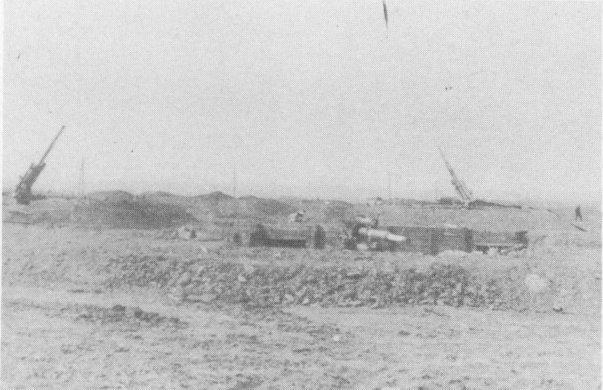
The battalion left Germany with the division on September 1, and sailed from Le Havre on September 11-United States bound.
During the last period of waiting before V-E Day, and during the periods of occupation afterwards, a large number of awards were presented to officers and men of the battalion. At Mittweida, more Air Medal Clusters were presented to Lts. Emil L. Barcklay, Lewis Blumberg, Frank W. Cleary, and Edward B. Ledford; and Sgt. Lawrence D. Minor and Cpl. Andrew P. Morris of Headquarters Battery received Bronze Stars. Ten days later Lt. Col. Phillip H. Pope and Tec. 4 Francis A. Travis of C Battery were presented the French Croix de Guerre at a ceremony in Altenburg.
While the battalion was at Holzdorf, several presentation ceremonies were held, and well over 100 medals and clusters awarded. Lt. Col. Pope received the Oak Leaf Cluster to the Silver Star. Silver Stars were presented to Capt. Paul A. Graham, Lts. Frank W Cleary, Woodrow W. Cobb, Harold P. McAnally, George R. Metcalf, Anton A. Pritchard, George Pogas, Nib R. Salemi, James W. Welden, Robert R. Wells, Jr., Milton Wolfman; 1st Sgt. Jerome J. Cura; Tech. Sgt. Joseph G. Keefe; S. Sgts. Ernest R. Cook, Kenneth D. Masters, William P. McCarthy; Sgts. Michael J. Mesiarik, James A. Morency, Edward T. Phillips, Lennart Plahn; Tec. 4's Lester M. Cannedy, John W. Newman, Francis E. Pyle, Francis A. Travis, Russell B. Studley; Cpls. Arthur D. Cornea, Wilfred Costa, Albert E. Murphy, Quinton Leathers, Jr., Earl R. Valentine; Tec. 5's Vincent E. Buzza, Olen R. Dudley, Roy E. Cross, William J. Leahy; Pfc.'s Robert D. Barker, Raymond C. Boyce, Thomas Campbell, Phillip J. A. Gallant, Charles E. Goodrich, Lawrence W. Moser, Chad E. Raney, Leroy M. Rothrock, John A. Ruis, Kenneth F. Smith, Shelby E. Smith, Francis P. Uvanni; and Pvt. James E. Behee. The Soldier's Medal was presented to Pfc. Edmund Ferreira.
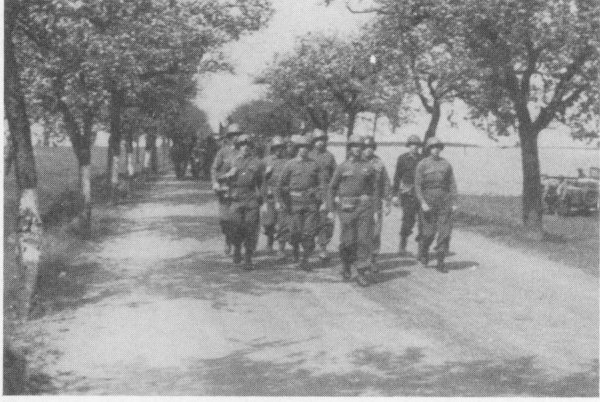
Bronze Star Oak Leaf Clusters were awarded to Maj. Joseph W. Menges; Capts. Frank J. Lee, Theodore H. Page, Jr.; Lts. Elmer J. Gruber, Donald S. Johnston, Milton Wolfman; and Tech. Sgts. Joseph Keefe and Lionel Lawrence. The following received Bronze Star Medals: Capts. Alvin W. Hoffman, Allen T. Porter: Lts. Thomas N. Blake, Joseph W. Stember, James W. Welden; WOJG's John Glenn, Kenneth E. Kennedy; M. Sgts. Carl Rosenstock, Raymond F. Torpey; 1st Sgts. Jerome J. Cura, Manuel S. Costa, Douglas F. Wilbur; T. Sgts. John J. Connolly, Morris M. Karlin; S. Sgts. Francis J. Angelo, James C. Brown, Donald F. Dean, Albert J. Griffin, Johnnie 0. Groce, William S. Harwood, Ralph A. Johnson, John J. Lucy, Robert V. Matteson, Everett F. Menice, Joseph C. Osborne; Sgts. William H. Anderson, William F. Bower, William C. Cafelle, Jr., Thomas P. Condon, John Connolly, John R. Gies, Robert D. Hawes, Gordon W. Haworth, David P. Hayes, Albert F. Lind, Charles J. Mallano, Roderick M. May, Harry F. Michalski, Leo E. Neagle, Jr., LeRoy Saint, Donald W. Sandford, Harold J. Sears, Ralph T. Shell, Charles R. Shelton, Manuel Silva, Joseph Viera, Jr.; Tec. 4's Oliva J. Bosse, William R. Gartrell, Edward G. Laferriere, Thomas B. MacQuinn, Edward J. Main, William T. McBride, Jr., John J. Porter, David Robshaw, Dan R. Rogers, Alvin A. Sonnenherg, Marcus C. Southworth; Cpls. Kenneth H. Burbank, Edward J. Espinola, David L. Fitting, Walter L. Goertz; Tec. 5's Marion 0. Barker, Jr., Harry F. Bethel, Elmer T. Burgess, Thomas D. Callahan, Ralph L. Carroll, John I. Crowe, John G. Dombroski, Alfred Fernandez, Joseph Herman, Otha F Home, Salvadore V. l???reco, Frank C. Luiz, Clayton E. Mann, Vincent F. Onellette, Henry L. Preston, Warren W. Priest, Charles H. Schuster, Joseph E. Szydlowski; Pfc's. Leroy Breault, Oscar L. Brissette, John A. Cameron, Chester J. Moskal, Alfred R. Neville, Zolton Tovay; Pvts. Everett L. Alden, Frank S. Dias.
In the Aschaffenburg area, the last awards were presented. Majs. Arnold M. Anderson, Joseph W. Menges; Lt. Arthur M. Frederick; and Tec. 5 John J. Kyranakis all received the Silver Star. Oak Leaf Clusters to Bronze Stars were awarded to Capts. Robert W. Baker, Lawrence W. Greene, Phillip C. Hawkes, Frank K. McDowell; and Tec. 5 Charles Gifford.
Lt. Robert R. Wells received a cluster to his Air Medal. Bronze Star Medals were presented to the following: T. Sgts. Everett Dashoff, John J, Wall; S. Sgt. Henry C. Zeitler; Tec. 3 Willford Olson; Tec. 4's Lonis A. Mando, Sidney H. Stouffer; Cpls. Eugene W. Latta, John M. Remeika; Tec. 5's Frank C. Hart, Willis M. Horton, Manuel J. Peters, James E. Phillips, Gilber A. Sylvia; Pfcs. George Arrow, Solomon M. Kutin, George Smith, and John D. Wilson.
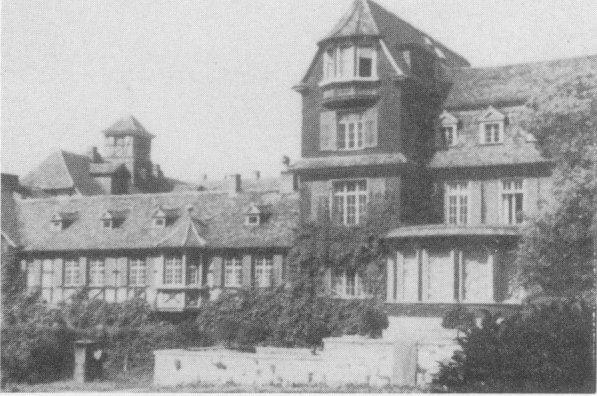
 PREVIOUS SECTION: To the Rhine
PREVIOUS SECTION: To the Rhine
 NEXT SECTION: Photographs -- Officers
NEXT SECTION: Photographs -- Officers
 Go to the 6th Armored Division Assoc. Home Page.
Go to the 6th Armored Division Assoc. Home Page.
 Information about the 212th FA and 6th Armored Division veterans' associations.
Information about the 212th FA and 6th Armored Division veterans' associations.
NOTE: Remove question mark from address below when sending email
This page is maintained by Bruce Frederick, EMAIL .
Last updated: August 9, 1997.